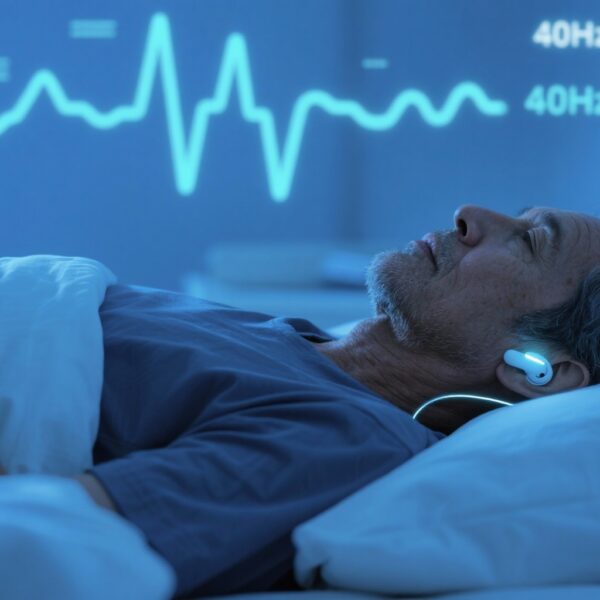Highlights
– 40‑Hz visual stimulation (VS) delivered during NREM and REM sleep produces frequency‑specific gamma-band EEG responses (SSVEP) comparable across sleep stages and wakefulness.
– In 30 healthy participants, nocturnal 40‑Hz VS increased 40‑Hz spectral power without objectively or subjectively degrading sleep beyond first‑night effects.
– Findings support feasibility for nocturnal gamma entrainment as a scalable experimental tool and a candidate noninvasive intervention for dementia, while highlighting the need for longer, disease‑targeted trials.
Background
Neuronal gamma oscillations (roughly 30–80 Hz) are implicated in attention, sensory processing, and memory consolidation. Experimental entrainment of gamma‑band activity — most commonly at 40 Hz — has attracted interest because preclinical data suggest it can modulate neuroimmune interactions and reduce hallmark pathologies of Alzheimer’s disease (AD) in animal models. Notably, seminal work demonstrated that sensory‑driven 40‑Hz entrainment reduced amyloid burden and altered microglial phenotype in transgenic mice, prompting translational efforts to test noninvasive sensory stimulation as a disease‑modifying strategy in humans (Iaccarino et al., Nature 2016).
Delivering patterned sensory stimulation during sleep is an attractive translational strategy for two reasons. First, sleep is a critical period for memory consolidation and glymphatic clearance; gamma entrainment during sleep might therefore interact with endogenous restorative processes. Second, nocturnal delivery could improve adherence and total exposure without requiring active participation. However, the feasibility and safety of applying 40‑Hz visual stimulation during human sleep—specifically whether it evokes neuronal gamma activity without fragmenting sleep—has been uncertain.
Study design
The study by Hainke and colleagues (Hainke et al., Sleep 2025) is a within‑subject, proof‑of‑concept polysomnography study in 30 healthy participants. Each participant spent two nights in a sleep laboratory: a control night and an experimental night with 40‑Hz visual stimulation (VS). Stimulation blocks were delivered in wakefulness (W), NREM sleep stages 2 and 3 (N2, N3), and REM sleep. High‑density EEG recordings were used to quantify spectral power at 40 Hz and to compute steady‑state visually evoked potentials (SSVEPs) in the time domain to assess specificity of entrainment. Subjective and objective sleep quality metrics were recorded to evaluate potential disruptive effects.
Primary endpoints were the presence and magnitude of 40‑Hz spectral power increases in the EEG during stimulation compared with control, and the effect of VS on sleep architecture and subjective sleep quality. Secondary analyses included time‑domain SSVEP confirmatory analyses and evaluation of carryover or first‑night effects on sleep measures.
Key findings
Evoked gamma activity
The principal finding is that 40‑Hz VS reliably increased spectral power at the stimulation frequency across wakefulness, N2, N3, and REM. Compared with the control night, spectral power at 40 Hz was elevated in all four stages during the experimental condition. The largest effect was observed in wakefulness, consistent with higher baseline responsiveness, and increases in N2, N3, and REM were of similar magnitude to one another—reported as large and medium effect sizes depending on stage and analysis. Time‑domain SSVEP analyses confirmed that the response was frequency‑specific, supporting a neuronal origin rather than broadband or movement artifacts.
Sleep quality and tolerability
Importantly for translational feasibility, the intervention did not meaningfully degrade objective sleep quality or subjective sleep reports beyond the expected first‑night adaptation to the laboratory environment. The authors report no systematic increases in awakenings, arousals, or stage shifts attributable to 40‑Hz VS when compared with the control night after accounting for first‑night effects. Subjective ratings of sleep quality were also unaffected. Together these data suggest that, in healthy adults, nocturnal 40‑Hz VS can be delivered without acute sleep fragmentation.
Additional observations
The study used multiple analytic approaches to demonstrate specificity of entrainment (spectral peaks at 40 Hz and SSVEPs) and evaluated responses across canonical sleep stages—an important advance over prior work that largely focused on wakeful stimulation. The within‑subject design (control vs experimental night) strengthens causal inference by controlling for interindividual variability.
Limitations of the primary data
The study reports feasibility in a relatively small cohort of healthy participants with acute, single‑night exposure. The sample size (n = 30) provides reasonable power to detect within‑subject changes in EEG metrics but is not sufficient to address long‑term safety, habituation to stimulation, efficacy on cognition, or effects in older adults and people with neurodegenerative disease. The authors appropriately frame their results as a proof‑of‑concept.
Expert commentary and implications
Mechanistic plausibility
The translational rationale rests on two complementary lines of evidence. First, 40‑Hz entrainment can modulate cortical and subcortical network activity, potentially influencing microglial function and protein clearance pathways implicated in AD, according to animal models (Iaccarino et al., 2016). Second, sleep itself modulates glymphatic flow and memory consolidation; delivering gamma‑band stimulation during sleep could theoretically synergize with these processes to augment clearance or plasticity.
Clinical potential and priorities for next steps
This study provides critical early human evidence that nocturnal 40‑Hz visual stimulation can engage the intended neurophysiological target (gamma‑band activity) without acutely compromising sleep in healthy adults. That is a necessary prerequisite before longer, outpatient or home‑based trials are undertaken in older adults or people with cognitive impairment.
Key priorities for future research include:
– Dose and scheduling: defining optimal daily duration, timing within the sleep cycle, and cumulative exposure for potential therapeutic effect.
– Population generalizability: testing older adults, individuals with sleep disorders, and patients with mild cognitive impairment or early AD to assess tolerability and physiological responsiveness.
– Clinical and biological endpoints: moving beyond EEG entrainment to examine effects on cognitive performance, sleep‑dependent memory consolidation, CSF and blood biomarkers (amyloid, tau, inflammatory markers), and PET imaging where feasible.
– Multimodal stimulation: comparing visual-only vs multisensory (audio‑visual) 40‑Hz protocols, given preclinical suggestions that multisensory approaches may enhance network engagement.
– Safety considerations: screening for photosensitive epilepsy risk, circadian phase shifts due to nocturnal light exposure, and long‑term effects on sleep architecture.
Limitations and cautions
Several important limitations should temper interpretation. First, entrainment demonstrated in young, healthy adults may be attenuated in older or pathological brains with altered cortical excitability and network connectivity. Second, acute entrainment does not prove downstream therapeutic effects; the causal pathway from transient gamma entrainment to reduced pathology in humans remains unproven. Third, photic stimulation carries a small risk of inducing seizures in susceptible individuals and could theoretically alter circadian timing if not carefully calibrated to intensity, spectrum, and timing.
Regulatory and pragmatic considerations
If future efficacy signals emerge, scaling nocturnal visual stimulation would require attention to device safety standards, usability for older adults, and safeguards for photosensitivity. Home deployment would need robust monitoring for adherence and sleep quality, ideally integrated with consumer or clinical EEG/actigraphy.
Conclusion
Hainke et al. provide proof‑of‑concept evidence that 40‑Hz visual stimulation delivered during both NREM and REM sleep evokes frequency‑specific gamma‑band responses without overtly disrupting sleep in healthy adults. These data establish feasibility for nocturnal gamma entrainment and support continued translational work to determine whether repeated nocturnal stimulation can influence cognitive outcomes or disease biomarkers in older populations and patients with neurodegenerative disease. Rigorous, longer‑duration randomized trials with clinically relevant endpoints and biomarker readouts are now warranted.
Funding and clinicaltrials.gov
Funding and trial registration details are reported in the original publication (Hainke et al., Sleep 2025). Readers and investigators should consult the full article for those specifics prior to designing follow‑on clinical studies.
References
Hainke L, Dowsett J, Spitschan M, Priller J. 40 Hz visual stimulation during sleep evokes neuronal gamma activity in NREM and REM stages. Sleep. 2025 Mar 11;48(3):zsae299. doi: 10.1093/sleep/zsae299. PMID: 39700417; PMCID: PMC11893540.
Iaccarino HF, Singer AC, Martorell AJ, et al. Gamma frequency entrainment attenuates amyloid load and modifies microglia. Nature. 2016;540(7632):230–235.
(For readers seeking broader context on gamma entrainment and translational efforts, these two references provide a concise starting point. Additional human feasibility and small pilot studies are under active development in the field.)



